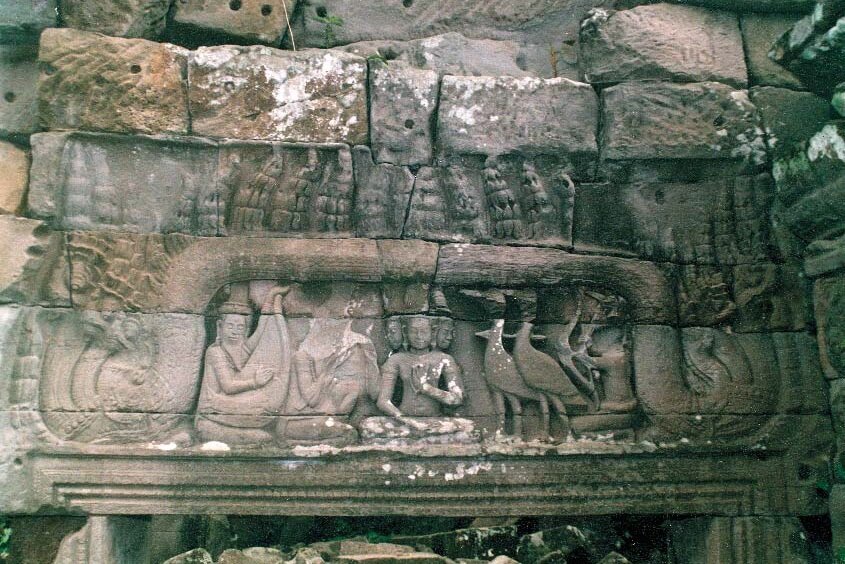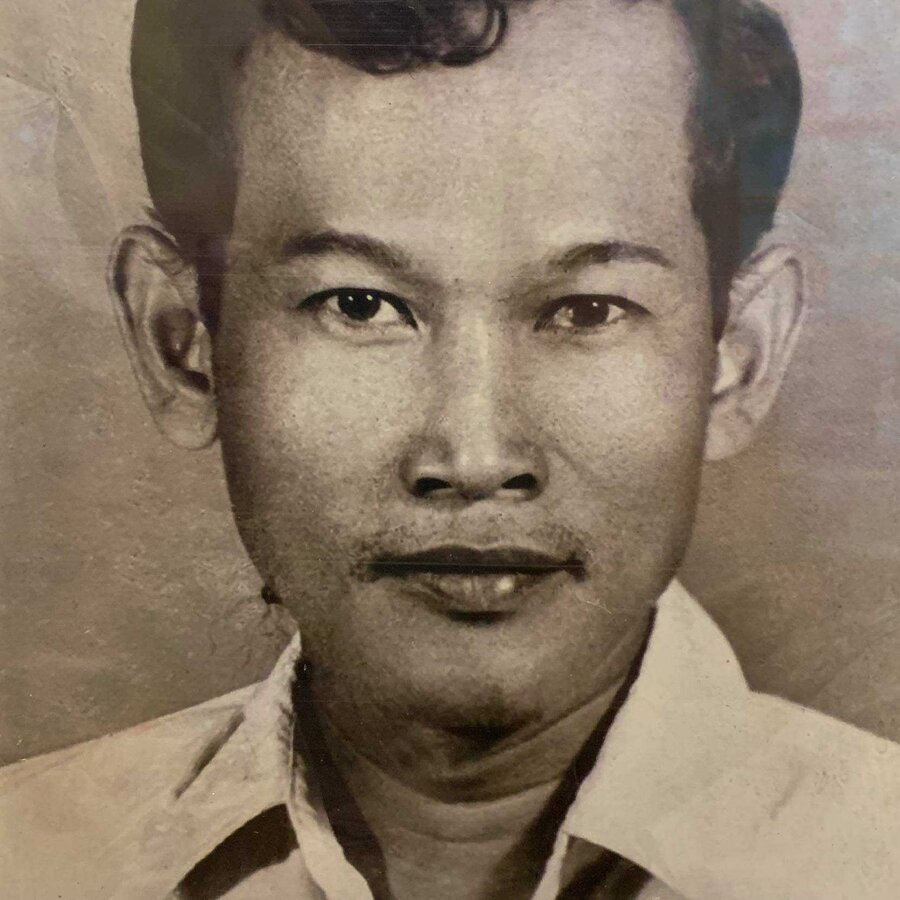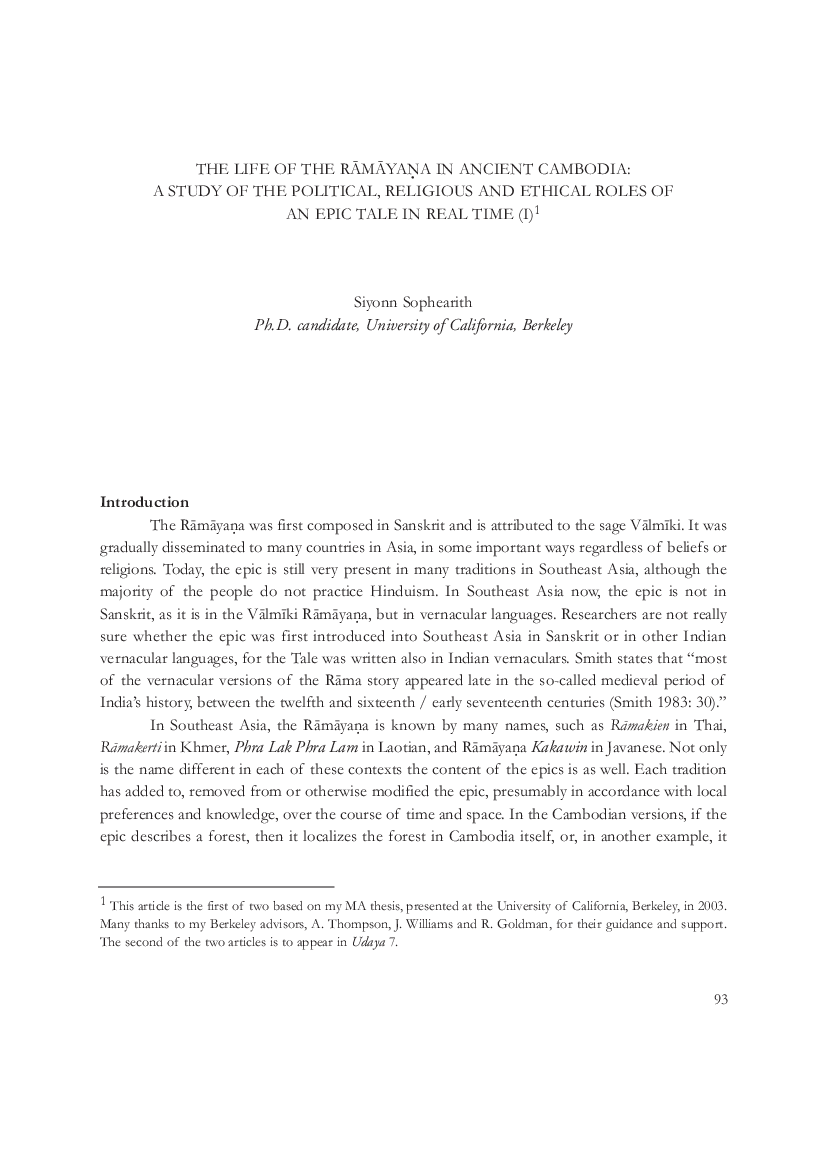The Life of the Ramayana in Ancient Cambodia: A Study of the Political, Religious and Ethical Roles of an Epic Tale in Real Time
by Sophearith Siyonn
A remarkable study in the Cambodian version of Ramayana through epigraphic and iconographic sources.

- Publication
- 2 parts, Part I: Udaya Journal, vol.6, 2005; Part II: Udaya Journal, vol. 7, 2006
- Published
- 2006
- Author
- Sophearith Siyonn
- Pages
- 86
- Language
- English
pdf 2.6 MB
The various Southeast Asian versions of the Ramayana saga differ in form, storyline, aesthetics, but have a common trait: we still do not know exactly how, by whom and when they were created. While some scholars have speculated that the Javanese Kakawin was the work of an anonymous poetess, it is clear that the Khmer version, Reamker (or Ramakerti, The Glory of Rama) was central to early Angkorian culture, and has evolved through oral traditions for centuries.
In ancient Cambodia, the impact of the Ramayana epic poem on arts, political power representations and folk culture is traceable through epigraphy and a thorough study of bas-reliefs. It reflects the evolution of the original story for political and artistic reasons. A tale full of sound, fury and dance. Here it is, In particular, what we learn from this richly illustrated essay.
Valmiki, the author of the Indian Ramayana
“Although without any associated concrete evidence in plastic art, several Khmer inscriptions also mention Vālmīki. A ninth-century inscription found to the northeast of Thnal Baray at Angkor, relates: La bouche des rois racontait sa gloire, et leurs femmes la chantaient: Rāghava n’a eu pour chantre que son propre fils, célébrant sa gloire telle qu’il l’avait entendu raconter par Vālmīki (Bergaigne 1893: 290, K. 281, face C, stanza XXVII). This inscription tell us that Vālmīki is a narrator of the Rāmāyana and he also teaches Rāma’s son(s) the story of Rāma as it is described in the Uttarakānda and the Bālakānda of the Vālmīki Rāmāyana. A vestige of a tenth-century inscription, of a Buddhist Terrace at Angkor Thom, reads “Le Guru, le fils de Bhrgu, Vālmīki… (Coedès 1942: 184, K. 491, st. I).” Together, these texts demonstrate that ancient Khmer knew of the sage Vālmīki. In middle period texts, Saveros Pou explains that Vālmīki is known as Vajjamrik. This new name is a result of phonetic mutation (Pou 1981: 21). Only the name Vālmīki appears to be known today, and this only through formal education based on colonial research. I have found only one iconographic example which I believe to refer to Vālmīki: an eastern pediment of the dancing hall of Banteay Chhmar, a temple dated to the twelfth – thirteenth century. At the center of the pediment, a four-faced god, none other than Brahmā, is sitting. On his right, two brahmans are paying homage to him. One of the brahmans is playing a harp and another brahman appears to chant or read texts to Brahmā. On Brahmā’s left, a hunter is shooting an arrow at two birds. This pediment may well recount two important scenes: the killing of the bird and the meeting of Vālmīki with Brahmā, with reference to Vālmīki’s grief and his composition.” (pp 11 – 2)
Rama and Cambodian Kings
“The epigraphy demonstrates that Rāma was well known in ancient Cambodia for having broken the bow, rather than shooting at a target, at Sītā’s Svayamvara. Again, in these references, we see the reigning Khmer king compared favorably to Rāma. The inscription of Pre Rup temple relates: ‘Etant échue à Rāma qui avait renoncé à la royauté et dont l’arc faible s’était brisé en tremblant, la Fortune fut autrefois ravie par l’ennemi; mais si la fille de Janaka était échue à ce roi fermement établi sur le trône et dont l’arc solide n’était pas brisé, elle n’aurait pas pu être enlevée (Coedès 1937: 112, K. 806, st. LI).” (p 20) “Epic episodes were used intentionally to compare actual situations to events in the Rāmāyana. Sometimes the episodes were metaphorically compared to actual events, for example, the battle of Lankā. The battle between Rāma and Rāvana was often compared to the battle between Khmer kings and neighboring kings. Noticeably, during the reign of King Jayavarman VII, the selected episodes were obviously matched to particular events and people. Coedès noted points of comparison between the story and actual events many times in his work. Later, Groslier, who was probably inspired by Coedès, precisely mentioned this in his short study dedicated to Rāmāyana in ancient Cambodia (Coedès 1952: 246, n. 1).” (p 69) “It is the Rāmāyana which, perhaps more than anything else (ritual, narrative, doctrinal texts…) manages to weave together these different aspects of life forming and constantly re-forming Khmer society.”(p 77)
Photo: A possible representation of the poet Valmiki (left of Brahma) on a Banteay Chhmaar pediment (photo by the author).
Tags: Ramayana, Reamker, Ramakerti, oral traditions, epic poetry, Khmer culture, early Cambodia, epigraphy, iconography, Rama, dance
About the Author

Sophearith Siyonn
Siyonn Sophearith is a lecturer of Cambodian History and Art History at the Royal University of Fine Arts, Phnom Penh, and the Director General of the Department of Statistics and Planning at the Intangible Culture Heritage Committee for Cambodia, UNESCO. He is also the Director of Khmer Renaissance.
In 2003, his MA thesis at the University of California-Berkeley dealt with the The Life of the Ramayana in Ancient Cambodia.

